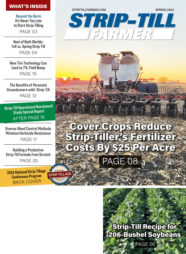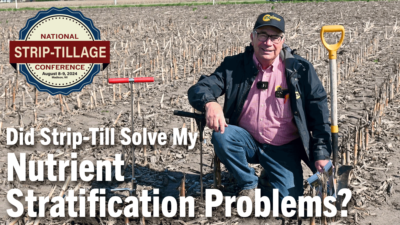Jason Wykoff is no stranger to precision farming technology. Since the 1990s, he’s been using it to develop yield maps to better manage field fertility, improve row spacing accuracy and reduce operator fatigue on 4,500 acres of seed corn, field corn and soybeans in northern Indiana.
“We cover a lot of geography, so we run three planters to get the crops in,” he says. Most fields are strip-tilled in the spring with a Case IH 580 Quadtrac pulling a 16-row Orthman 1tRIPr strip-till machine that applies fertilizer rates optimized for that particular field.
This tillage pass is followed by a pass with one of three 16-row planters — a Cat Challenger 755 pulling a john Deere 1775 planter, a Case IH 310 Magnum pulling a John Deere 1770NT planter and a John Deere 8320T pulling a John Deere 7200 planter.
Each tractor uses a different guidance system, which creates challenges. The Challenger uses a Trimble 1000 receiver and the Magnum uses a Case IH Pro 700 receiver for auto-guidance. Wykoff says those two systems work together well, but the Deere uses a GreenStar 2630 for guidance.
“We can interchange the Trimble and the Case IH units in fields because they use the same A-B line, but the Deere system uses a different A-B line, so the auto-guidance systems don’t match up,” he says.
Wykoff has used three different RTK signals from base stations to match the specific controller and was forced to use the Deere system in some areas because it was the only RTK signal available.
Auto-guidance is also used heavily for spraying, variable-rate lime application, harvest guidance and yield monitoring.
“This year, we went to an RTX signal and it worked well, but getting the satellite convergence takes some time in the field,” Wykoff says. “We try to use the same A-B lines from year to year, shifting them as needed to better manage the rows.”
Points of Pain: Multiple Subscription Headaches
With a rainbow of GPS controllers, Wykoff gets frustrated with the lack of cross-functionality between systems.
“When we were looking at upgrading to RTX, we had to choose between a 450 mHz or 900 mHz signal, but it meant we had to change out the radio on at least one of the receivers,” he says. “Precision farming is like a drug to farmers using it — we are hooked and are forced to pay $500-$1,000 a year subscription fee per receiver. We have no choice.”
Even with the RTX signal, Wykoff finds accuracy varies up to 3 inches from field pass to field pass. “If we are off 1.5 inches on our north field pass and another 1.5 inches off on our south field pass, we are 3 inches off per round and that adds up pass after pass.
“Equipment drift on sidehills and how the strip-till unit vs. the planter drifts also affects row accuracy,” he says. “I think we are 100% accurate about 40% of the time.”
Wykoff has been impressed with the knowledge and experience of precision equipment techs, but says in the heat of spring or fall work, there simply aren’t enough of them. “We invest in this equipment for greater productivity and efficiency, trying to cover more acres in a day. It’s extremely frustrating when they can’t get there when you need them. Maybe if the industry would further adopt ISO 9000 standards, some of these issues wouldn’t be so great, but I don’t see that happening soon enough,” he says.







Post a comment
Report Abusive Comment